The encampment clearing that took place in January of 2018 at an L Street NE underpass, on one of the coldest weeks of the winter, was sadly nothing new to our community. DC government insists on conducting twice-weekly encampment “clean ups” year-round. However, the optics and the consequences of that January clearing were a damning testament to the priorities of those who are guiding development in DC. The area that has served as home base for some of our neighbors experiencing homelessness was cleared out and then fenced off completely, displacing them from even their place on the streets. Why? To make way for an “art installation.”
As new and expanding ‘”tent cities”’ are established by people experiencing homelessness throughout the United States, media attention on the issue is increasing, with even international outlets taking note– check out “Homeless swept up in America’s capital clean-up” from BBC, and “San Francisco or Mumbai? UN Envoy encounters homeless life in California” from The Guardian’s Outside in America series. The depth and breadth of media coverage of tent cities informed a December 2017 report released by the National Law Center on Homelessness & Poverty on the rapid growth in tent cities across the United States. As with any other uptick in symptoms of housing instability, the creation of truly affordable housing sufficient to meet the need is the only solution that will address the structural factors that give rise to the systemic problem of tent cities. However, as the report notes, encampments “can provide important stability for people and their belongings that can actually enable them to get off the streets more quickly, or at a minimum improve their quality of life while homeless.”
These encampment clearings do nothing to address the underlying factors that contribute to prosperous Washington, DC holding the dubious distinction of the highest per capita rate of homelessness in the nation. They are an in–your-face example of the pattern of displacement that has become the constant companion of redevelopment in the District, as shelter space and affordable housing continue to dwindle in the face of gentrification. These clean-ups can also be dangerous as they often result in the destruction of the only means that encampment residents have to stay warm and safe in the cold: their tents, blankets, clothing and other belongings. Washington, DC government has a Protocol for Disposition of Property on Public Space, which governs this type of operation. However, District government has in many cases refused to comply with the requirements of its own Protocol, by throwing away what are often the only possessions owned by people who have been forced to sleep outside.
Access to emergency shelter is vital – it can mean the difference between life and death, particularly during extreme weather. But it is important to note that there are many reasons why people experiencing homelessness might truly feel that sleeping on the streets is a safer alternative, or even their only choice. The DC government has acknowledged that it does not have sufficient shelter capacity, particularly for women, meaning that every night there are women experiencing homelessness who have no choice but to sleep outside. If a heterosexual couple becomes homeless and does not have children, they are faced with the choice of separating from one another in order to enter the singles shelter system, or staying together outside. Someone who experiences a health issue that suppresses their immune system may be putting their health at risk by entering a crowded singles shelter where conditions can be abysmal. If someone has mental health issues, they may feel unsafe and paranoid in a singles shelter, or be unable to comply with shelter rules and face conflict with staff or other residents.
Encampments are visible symptoms of the District’s homelessness crisis. Clearing people away addresses optics, not the crisis itself. It can also further traumatize our neighbors who are already living at the margins as luxury redevelopment springs up around them, constantly signaling that their presence is considered a nuisance. The current manner in which the District is clearing encampments is a cruel use of taxpayer money. It also violates the Constitutional rights of encampment residents, which is the basis for a class action lawsuit recently filed against the District over its encampment clearing practices. For more information regarding this suit, contact Legal Clinic staff attorney Ann Marie Staudenmaier, at Annmarie@legalclinic.org.
All residents should be heard and considered by our elected officials, not just those who have enough income to live comfortably in the District, which is broadly considered to be one of the most expensive places to live in the United States. If you have thoughts about how elected officials should be treating our neighbors experiencing homelessness, please contact the office of Deputy Mayor for Health and Human Services HyeSook Chung, to voice your concerns.
The Legal Clinic is a resource for those who have had their rights violated during the course of one of these encampment clearings. If you or someone you know wishes to speak with an attorney about those rights, please contact our main line at 202-328-5500.





